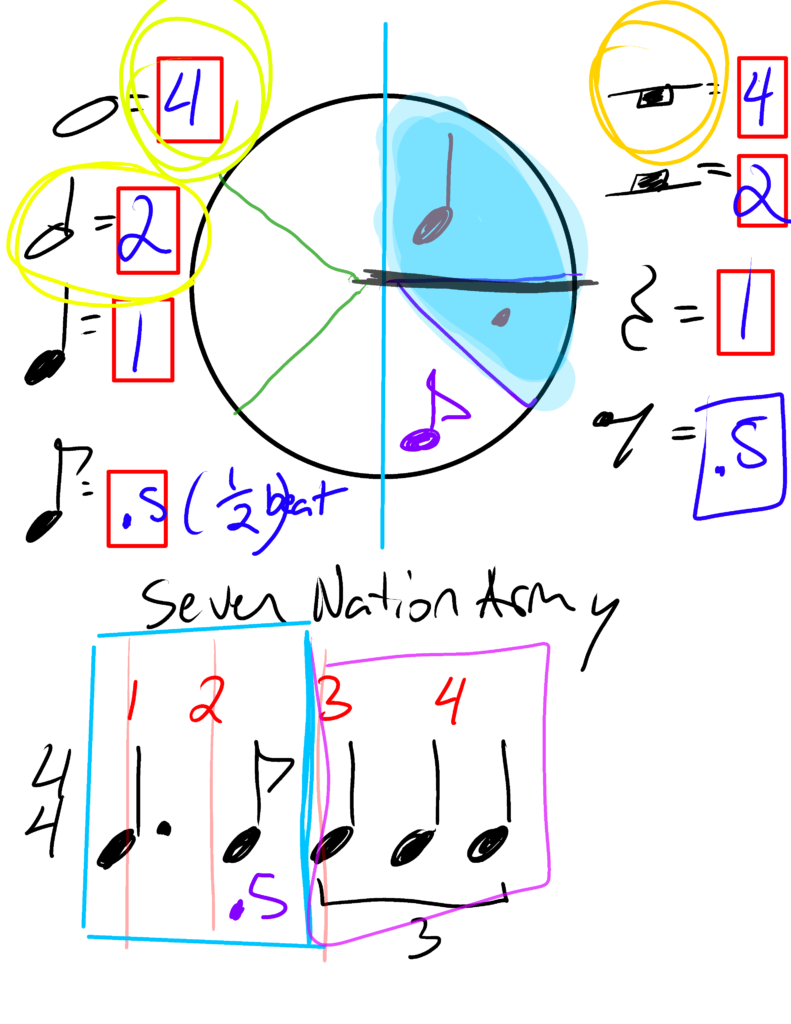Artifacts and Reflections
PRACTICUM 1:
These two artifacts reflect before and after formative learning during the early stages of my first in-class-teaching practicum. I had Grade 6/7 Band students between five different elementary schools.
My first attempt at using my concept below did not go well. The first image is an artifact from the second lesson I taught on rhythm. It is overly complicated and difficult to read. I did not see the positive impact on students’ learning that I expected. I observed many students not reading the sheet and not following along during the lecture. My inspiration behind this lecture was using the medicine wheel to conceptualize the interconnectedness of rhythm and time. While the concept was good, the execution needed improvement.
BEFORE (Early stages with this concept):

The second time I taught a similar lesson to a more beginner group. This time, I did not use the sheet above. Instead, I used my iPad as a white board. First, I reviewed the values of notes (how many beats does one note get). Then, I reviewed the values of rests. Notes represent playing, and rests represent silence. Then, I told the students to imagine a wheel as one bar of music. A bar is a way of “chunking” the divisions of time. In the time signature of 4/4, that means there are four beats within one bar. What insured my success during this lesson was the iPad — a novelty that interested the students and peaked their intrigue — and the manner in which I reviewed what they already had learned as an entry point into the concept. I used the colour circling to help students follow along where were were from moment to moment, and I asked for student participation to fill in the boxes with answers. Then, tying into the lesson I wanted to teach for the rest of the lesson on a difficult new song, we approached the rhythm from the standpoint of “what is the easiest answer first.” You will see that a pale blue line separates the first part of the bar, on the right, and the second part of the bar, on the left. This concept uses a wheel going clockwise, starting at the top, to determine where the beats are. Then, we used cross-curricular concepts in math to solve this puzzle. I also used questions to engage the class. When figuring out the triplet, or the second half of the bar (the left side of the circle), I asked the students how they would divide half of cake evenly between three people. This was how they were so easily able to conceptualize the triplet. I also allowed a student to draw the lines and called the apple pen the “pen of destiny,” as I enjoy being dramatic and I try to be funny. Or, if not funny, entertaining.
What really made me happy at the end, was that my CT told me that she’d never had a class that could play this difficult song and rhythm for a concert recording before. After this lesson, almost all the kids loved this tune and practiced it hard and succeeded with the triplet every time, which is a hard task to ask of a senior band some days, let alone beginners who have been playing their instruments for two months. I was so proud. And I am so proud of those wobbly green lines below where the student perfectly drew this visual representation of a triplet in music on this wheel. This lesson was one of my highest moments from the first practicum.
AFTER (late stages with this lesson concept):
